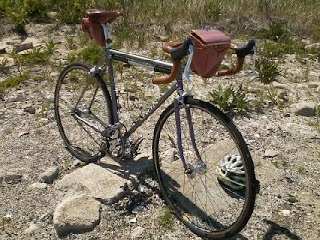Today was an absolutely glorious day, weather-wise, and I didn't have to worry about spectacles of animal exploitation clogging area roadways. In fact, given that it was Sunday, there was scarcely a cloud in the sky and little humidity, and the temperature reached 24C (75F), I was surprised to see as little traffic as I did anywhere I rode.
Even the beach areas were pretty quiet. I rode down to the Rockaways, flipped a quarter and continued to Point Lookout. Some people were walking about on the beach and the boardwalks in the Rockaways and Atlantic Beach. But they didn't seem to linger, surprisingly enough. The water is still a bit cooler than some people like for swimming. That might be a reason why there weren't as many people as I expected. Also, there didn't seem to be many events as there were last weekend or the weekend before, which included Memorial Day.
Of course I didn't mind. I just rode and took a couple of self-indulgent shots of Tosca, my fixed-gear Mercian:
Actually, I took the photos because in the light of that beach, and the angle from which I was looking when I sat down, I could see the "flip-flop" quality of the finish: It actually looked purple and green at the same time. I don't think it came through in these photos. Oh well.
I had a great ride with Tosca. That's what matters.
Even the beach areas were pretty quiet. I rode down to the Rockaways, flipped a quarter and continued to Point Lookout. Some people were walking about on the beach and the boardwalks in the Rockaways and Atlantic Beach. But they didn't seem to linger, surprisingly enough. The water is still a bit cooler than some people like for swimming. That might be a reason why there weren't as many people as I expected. Also, there didn't seem to be many events as there were last weekend or the weekend before, which included Memorial Day.
Of course I didn't mind. I just rode and took a couple of self-indulgent shots of Tosca, my fixed-gear Mercian:
Actually, I took the photos because in the light of that beach, and the angle from which I was looking when I sat down, I could see the "flip-flop" quality of the finish: It actually looked purple and green at the same time. I don't think it came through in these photos. Oh well.
I had a great ride with Tosca. That's what matters.

























